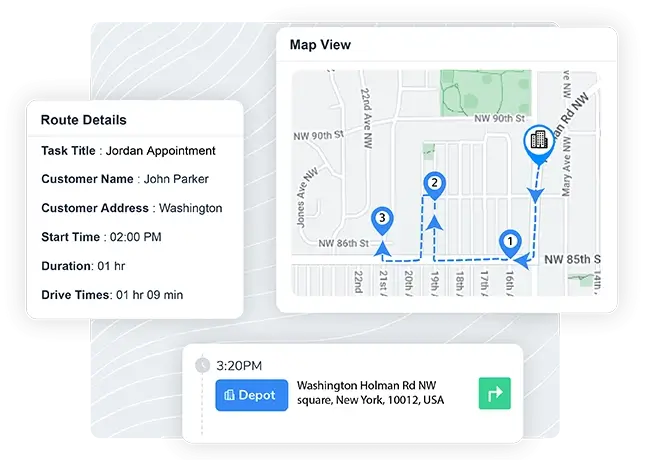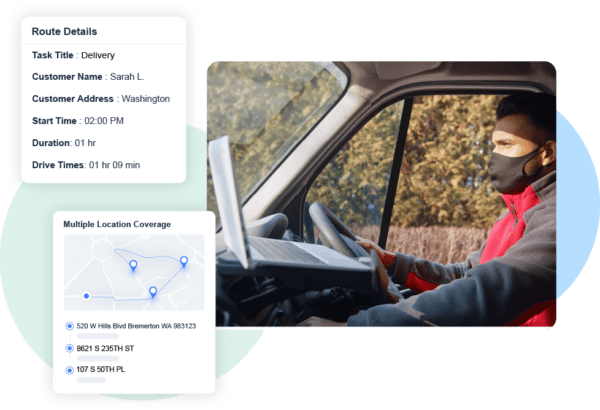
In this breakneck speeding world, where customers expect timely deliveries and businesses demand cost-effective operations, efficient delivery route planning has become indispensable.
The evolution of technology has revolutionized delivery logistics, offering innovative solutions to optimize transportation routes and streamline supply chain efficiency.
Delivery route planning and route optimization softwares stand at the forefront of this transformation, providing businesses with powerful tools to navigate the complexities of modern logistics. This blog delves into the essentials of these software solutions, shedding light on their importance, functionalities, and benefits.
Whether you’re a small local delivery service or a large-scale logistics provider, understanding and leveraging the capabilities of a good route optimization software can significantly enhance your operational efficiency and customer satisfaction. Join us as we explore the world of delivery logistics and uncover the secrets of successful route planning and optimization.
Route Planning and Optimization Software
A Routing software is often referred to as route planning software, that is designed to help businesses plan, optimize, and manage their transportation routes effectively.
It utilizes advanced algorithms and real-time data to create the most efficient routes, considering factors such as; traffic conditions, delivery windows, and vehicle capacities.
This software plays a pivotal role in transportation management and fleet management, and enables businesses to reduce costs and improve delivery time predictions.
Any popular route optimization software on the market employs optimal route planning algorithms to find the most efficient sequence of stops, minimizing travel time and distance.
This is particularly beneficial for businesses with multiple stops or complex delivery requirements, such as last-mile delivery services. By leveraging route optimization techniques, businesses can enhance supply chain efficiency and reduce operational costs significantly.

How Does Route Optimization Work?
Route optimization works by analyzing various factors that influence route efficiency, such as traffic patterns, delivery windows, and other team characteristics. The software uses this data to generate optimal routes, taking into account multiple stops and constraints.
With real-time route planning capabilities and GPS tracking, businesses can adapt to changes on the fly, ensuring timely deliveries and minimizing disruptions.
The Importance of Delivery Route Planning and Route Optimization Software
Delivery route planning and optimization software have become essential for businesses operating in the logistics and transportation sectors. Their importance cannot be overstated, as they play a critical role in enhancing efficiency, reducing costs, and improving customer satisfaction. Below are some key reasons highlighting the significance of these software solutions:
Enhancing Efficiency
Efficiency is at the core of any successful logistics operations. With a delivery route planning software, businesses can optimize routes to minimize travel time and distance, ensuring drivers to complete more deliveries in less time. This not only improves productivity but also allows businesses to serve a larger customer base without increasing their fleet size.
Cost Reduction
Cost management is a key concern for businesses in the transportation industry. Route optimization softwares helps reduce fuel consumption, vehicle wear and tear, and labor costs by generating the most efficient routes. By cutting down on unnecessary miles and idle time, Businesses can achieve significant cost savings in the long run.
Improving Customer Satisfaction
Timely deliveries are crucial for maintaining high levels of customer satisfaction. A good Route optimization software can provide accurate delivery time predictions and real-time tracking capabilities, allowing businesses to meet delivery windows consistently. This leads to improved customer trust, loyalty, and repeat business.
Streamlining Operations
Managing a fleet of vehicles and coordinating multiple deliveries can be a complex task. A delivery route planning software can simplify this process by automating route planning, dispatch management, and real-time tracking. This enables businesses to streamline operations, reduce administrative burdens, and focus on core business activities.
Adapting to Dynamic Conditions
The logistics landscape is constantly evolving, with factors like traffic congestion, weather conditions, and customer preferences impacting delivery operations. Route optimization softwares can adapt to these dynamic conditions by providing real-time updates and allowing on-the-fly route adjustments. This flexibility ensures that businesses can navigate challenges effectively and maintain service excellence.
Enhancing Safety and Compliance
Delivery route planning and optimization softwares not only focus on efficiency and cost reduction but also help prioritize safety and compliance. By selecting the safest and most compliant routes, businesses can minimize the risk of accidents, traffic violations, and regulatory penalties.
These software solutions often integrate features such as road condition monitoring, hazardous route avoidance, and compliance with transportation regulations. By prioritizing safety, businesses can protect their drivers, vehicles, and reputation while ensuring adherence to legal requirements, ultimately fostering trust and reliability among customers and stakeholders.
Stop Losing Time (and Money) on Inefficient Routes
With Arrivy’s Route Optimization, you’ll cut miles, save money, and deliver on time—every time.
How to Optimize Delivery Routes Actively?
Optimizing delivery routes involves several steps:
Data Collection
This step involves gathering crucial information to facilitate efficient route planning. Delivery locations, time windows (the periods during which deliveries must be made), vehicle capacities (how much each vehicle can carry), and traffic conditions are key factors to consider.
This data can be collected through various means, including historical delivery records, customer input, and real-time traffic monitoring systems.
Route Planning
Once the necessary data is collected, route optimization software comes into play. This software utilizes algorithms to analyze the data and generate the most efficient delivery routes.
The goal is to minimize driving time, distance, and fuel consumption while adhering to delivery constraints such as time windows and vehicle capacities. These optimized routes can significantly improve overall delivery efficiency and reduce operational costs.
Real-Time Adjustments
Despite careful planning, unexpected events can occur during delivery operations, such as traffic jams, road closures, or last-minute order changes. Real-time GPS tracking allows for monitoring of delivery vehicles as they navigate their assigned routes.
When issues arise, such as delays or changes in traffic conditions, adjustments can be made on the fly to ensure timely deliveries. This adaptability is crucial for maintaining customer satisfaction and optimizing resource utilization.
Evaluation and Iteration
After completing deliveries, it’s important to evaluate the performance of the optimized routes. This involves analyzing various metrics, including delivery times, fuel consumption, vehicle utilization, and customer feedback.
Route optimization tools provide valuable insights into the effectiveness of the planned routes and identify areas for improvement. By continuously evaluating performance and making adjustments based on feedback and data analysis, delivery operations can be fine-tuned over time to achieve optimal efficiency and customer satisfaction.
Effective delivery route optimization involves a cycle of data collection, planning, real-time adjustments, and evaluation. By leveraging technology and data-driven approaches, businesses can streamline their delivery operations, reduce costs, and enhance customer service.
Most Essential Attributes to Consider While Operating Route Optimization Software
Multi-Stop Route Optimization
Utilizing advanced algorithms, multi-stop route optimization efficiently plans delivery routes by minimizing driving time and distance between stops, ensuring timely deliveries and optimizing resource utilization.
By consolidating multiple stops into optimized routes, businesses reduce fuel costs, vehicle wear, and overall delivery time, boosting operational efficiency and customer satisfaction.
Delivery Time Predictions
Leveraging predictive analytics and real-time traffic data, businesses provide accurate Estimated Time of Arrivals (ETAs) to enhance transparency and trust with customers.
By analyzing historical delivery data and traffic patterns, delivery time predictions accommodate various scenarios, enabling customers to plan effectively and reducing the likelihood of missed deliveries, fostering stronger customer relationships.
Dispatch Management
Automated scheduling software optimizes routes, assigns tasks, and provides real-time updates on delivery statuses, streamlining dispatch operations.
With GPS tracking, dispatchers monitor progress, make necessary adjustments for delays or route deviations, and respond promptly to changing conditions, improving overall delivery performance and customer satisfaction while reducing errors and inefficiencies.
Cost Saving
Implementing cost-saving measures is essential for optimizing delivery operations. Route optimization software minimizes fuel consumption and vehicle wear by generating efficient routes with fewer miles traveled and reduced idle time. Optimizing vehicle utilization ensures each vehicle is fully utilized, minimizing unnecessary trips and maximizing efficiency.
Businesses can also explore alternative fuel options, such as electric or hybrid vehicles, to further reduce operating costs and environmental impact. By continuously monitoring and optimizing delivery processes, businesses identify cost-saving opportunities and improve profitability while maintaining service quality.
Turn Route Chaos into Predictable Efficiency
Arrivy gives you complete control of your fleet while boosting customer satisfaction.
Challenges and Considerations of Route Optimization Softwares
Route optimization softwares can significantly streamline logistics operations for businesses, but there are several challenges and considerations to keep in mind:
Complexity of Route Networks
Route optimization becomes increasingly complex as the number of locations, vehicles, and constraints (such as delivery time windows, vehicle capacities, and traffic conditions) increases. Software must be able to handle these complexities efficiently.
Real-Time Data Integration
Keeping route plans updated in real-time with accurate data on traffic conditions, weather, road closures, and other factors is crucial for effective optimization. Integrating with live data sources can be challenging and requires robust data management capabilities.
Scalability
Route optimization software must be able to scale effectively as the size of the operation grows. This includes handling larger fleets, more delivery points, and increased transaction volumes without sacrificing performance or accuracy.
Customization and Flexibility
Businesses often have unique requirements and constraints that need to be accommodated in route optimization algorithms. The software should allow for customization and flexibility to tailor routes according to specific business needs.
Multi-Objective Optimization
Many route optimization problems involve multiple conflicting objectives, such as minimizing distance traveled, reducing fuel costs, and maximizing customer satisfaction. Balancing these objectives and finding optimal solutions can be challenging.
Integration with Existing Systems
Route optimization software needs to seamlessly integrate with other systems such as CRM (Customer Relationship Management), and fleet management software to exchange data and streamline operations.
User Interface and Usability
The software should have an intuitive user interface that makes it easy for dispatchers and drivers to interact with and understand route plans. Usability is crucial for adoption and efficiency.
Regulatory Compliance
Compliance with regulations such as driving hours limits, vehicle weight restrictions, and environmental regulations may impact route optimization decisions. The software should be able to take these factors into account to ensure legal compliance.
Addressing these challenges requires a combination of advanced algorithms, robust data management capabilities, seamless integration with existing systems, and ongoing support and customization to meet the evolving needs of businesses.
Conclusion
Delivery route planning and optimization softwares are indispensable tools for modern businesses looking to streamline their logistics operations and improve supply chain efficiency. By leveraging advanced algorithms, real-time data, and innovative features, these software solutions enable businesses to reduce costs, enhance customer satisfaction, and achieve sustainable growth.
Whether you are in the transportation industry or managing a fleet of vehicles, investing in the best route-planning software can make a significant difference in your operational success.
Remember, the key to successful delivery logistics lies in effective planning, optimization, and execution. With the right tools and strategies in place, businesses can navigate the complexities of modern supply chains with ease, ensuring timely deliveries and satisfied customers.
